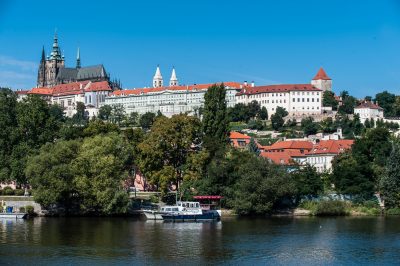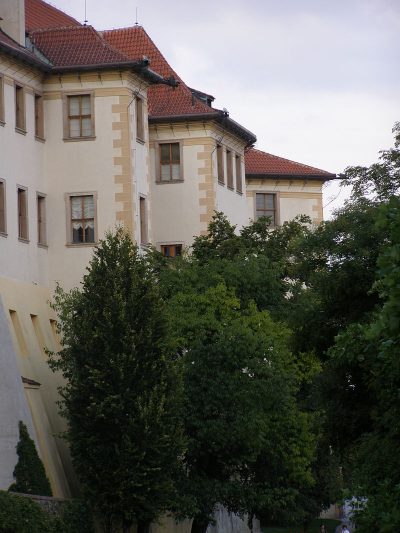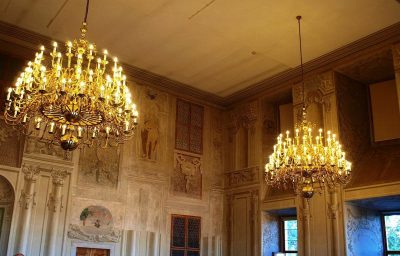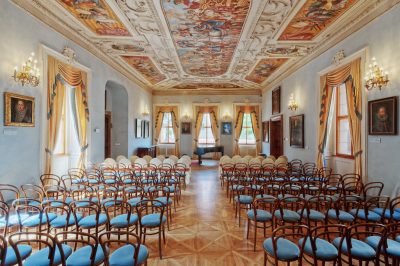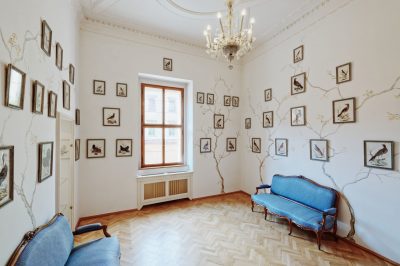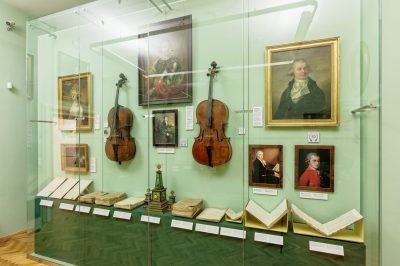The Lobkowicz Palace at Prague Castle is one of the most significant cultural sites in the Czech Republic and the only privately owned building in the Prague Castle complex, a UNESCO World Heritage Site. Through the centuries, the Palace witnessed some of Bohemia’s most important historical events.
Historical Origins
Lobkowicz Palace was built in the second half of the 16th century by the Czech nobleman Jaroslav Pernštejn (1528-1569). It was Jaroslav’s sister-in-law, Maria Maximiliana Manrique de Lara y Mendoza, wife of his brother Vratislav, Chancellor of the Czech Kingdom (1530-1582), who brought the celebrated Infant Jesus of Prague statue from her homeland of Spain to the Palace, where it became well-known for its miraculous healing powers. The statue was later given by Vratislav and Maria Maximiliana’s daughter, Polyxena (1566-1642), to the Church of Our Lady Victorious in Prague, where it remains on display and attracts thousands of visitors each year. A copy of the Infant Jesus of Prague is on permanent display in the Lobkowicz Palace Museum.
The Palace came into the Lobkowicz family through the marriage of Polyxena to Zdeněk Vojtěch, 1st Prince Lobkowicz (1568-1628). In the centuries following that marriage, the Palace witnessed some of Bohemia’s most significant historical events. In 1618, the famous Defenestration of Prague took place when Protestant rebels threw the Catholic Imperial Ministers from the windows of the Royal Palace at Prague Castle. Surviving the fall, they took refuge in Lobkowicz Palace, where they were protected from further assault by Polyxena, 1st Princess Lobkowicz.
Following the defeat of the Protestant faction at the Battle of White Mountain in 1620, the Catholic Lobkowicz family consolidated its influence and power base for the next three centuries. Lobkowicz Palace took on a more formal, Imperial role and functioned as the Prague residence when the family needed to be present at the seat of Bohemian power for political and ceremonial purposes.
With the exception of the sixty-three years (1939-2002) during which the property was confiscated and held by Nazi and later Communist powers, the Palace has belonged to the Lobkowicz family.
Significant Architectural Features
After the Thirty Years War, the Palace underwent a number of significant changes, particularly under Václav Eusebius, 2nd Prince Lobkowicz (1609-1677). He was responsible for the Palace’s significant baroque alterations and some of its more lavishly decorated salons.
Václav Eusebius redesigned the Palace in the Italian manner. His design influence can be seen today in the Imperial Hall, whose walls are painted in fresco with trompe l’oeil statues of emperors surrounded by geometric designs, floral and other decorative motifs. Additional examples of the Italianate style can be found in what are referred to as the Concert Hall and the Balcony Room, whose ceilings are adorned with elaborate painted stuccowork and sumptuous frescoes by F.V. Harovník.
In the 18th century, Joseph František Maximilian, 7th Prince Lobkowicz (1772-1816), commissioned the reconstruction of the exterior of the Palace in preparation for the coronation at Prague Castle of Emperor Leopold II as King of Bohemia (1791). The alterations included the addition of the panoramic balconies that visitors to the Palace still enjoy today.
In spite of the various alterations made through the years, remnants of original 16th-century murals and sgrafitto work can still be seen in both of the interior courtyards.
Recent History
After World War I, and following the abolishment of hereditary titles in 1918, Maximilian Lobkowicz (1888-1967), son of Ferdinand Zdenko, 10th Prince Lobkowicz (1858-1938), demonstrated his support for the fledgling First Republic of Czechoslovakia by making several rooms at the Palace available to the government headed by Tomas G. Masaryk, President and founding father of the First Czechoslovak Republic.
In 1939, the invading Nazi forces confiscated the Palace along with all other Lobkowicz family properties. The Palace was returned in 1945, only to be seized again after the Communist takeover in 1948. For the next forty years, the Palace was used for a variety of purposes, including State offices and as a museum of Czech history.
After the Velvet Revolution of 1989 and the subsequent fall of the Communist government, President Václav Havel enacted a series of laws that allowed for the restitution of confiscated properties. Following a twelve-year restitution process, the Lobkowicz family once again became the rightful owner of its Palace in 2002.
On April 2, 2007, after more than four years of planning, restoration and refurbishment, the Palace was opened to the public for the first time as the Lobkowicz Palace Museum, home to one part of The Lobkowicz Collections. This new reincarnation of the Palace not only revitalizes an important cultural site in the heart of Europe, but also dramatically expands the Lobkowicz family’s efforts to make The Collections accessible to Czech and international audiences alike.
Address
Address:
Jiřská 3, 119 00 Praha 1
GPS:
50.0916918462, 14.4040813375
Telephone:
Email:
Opening Hours
Monday
10:00 - 18:00
Tuesday
10:00 - 18:00
Wednesday
10:00 - 18:00
Thursday
10:00 - 18:00
Friday
10:00 - 18:00
Saturday
10:00 - 18:00
Sunday
10:00 - 18:00


